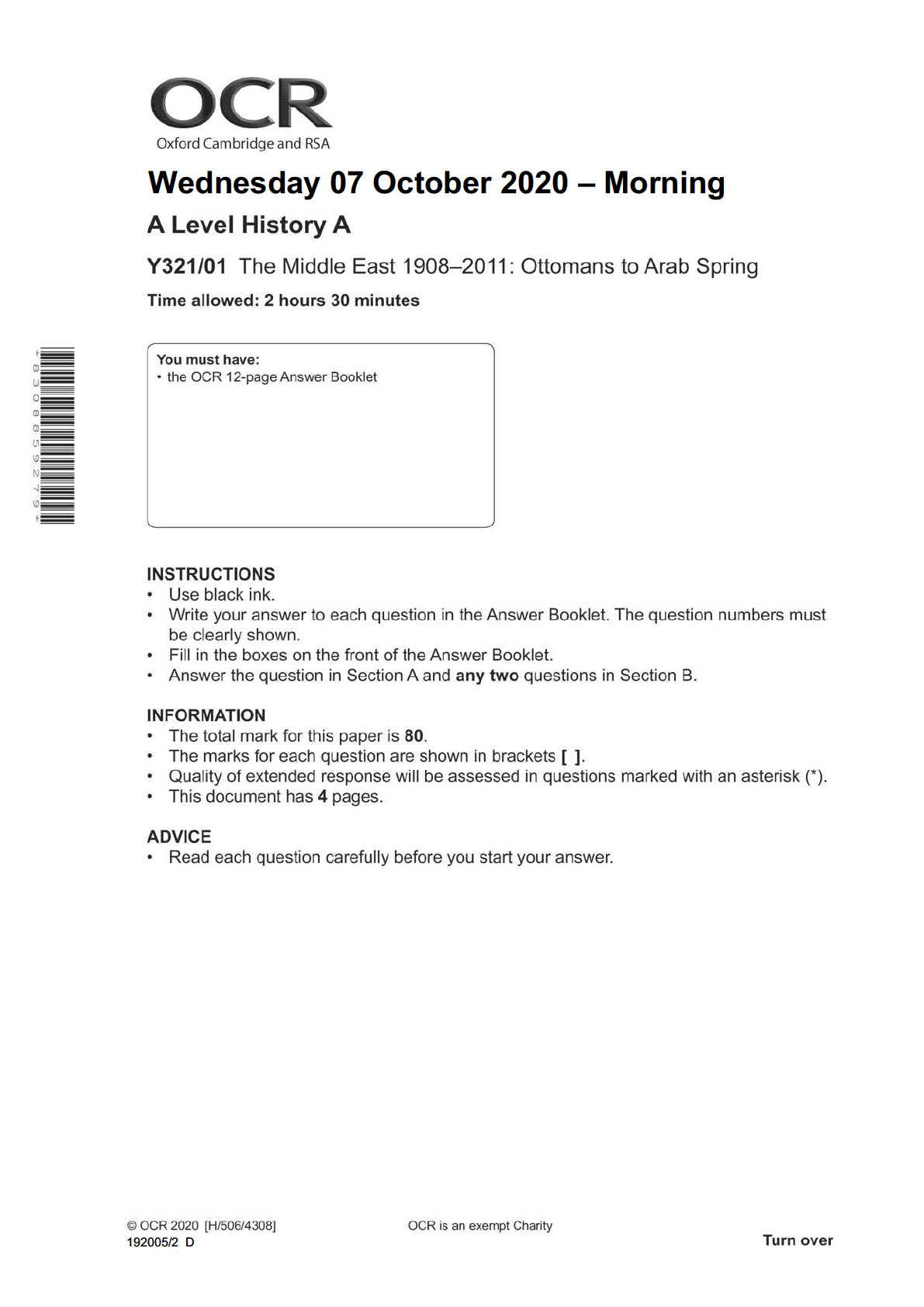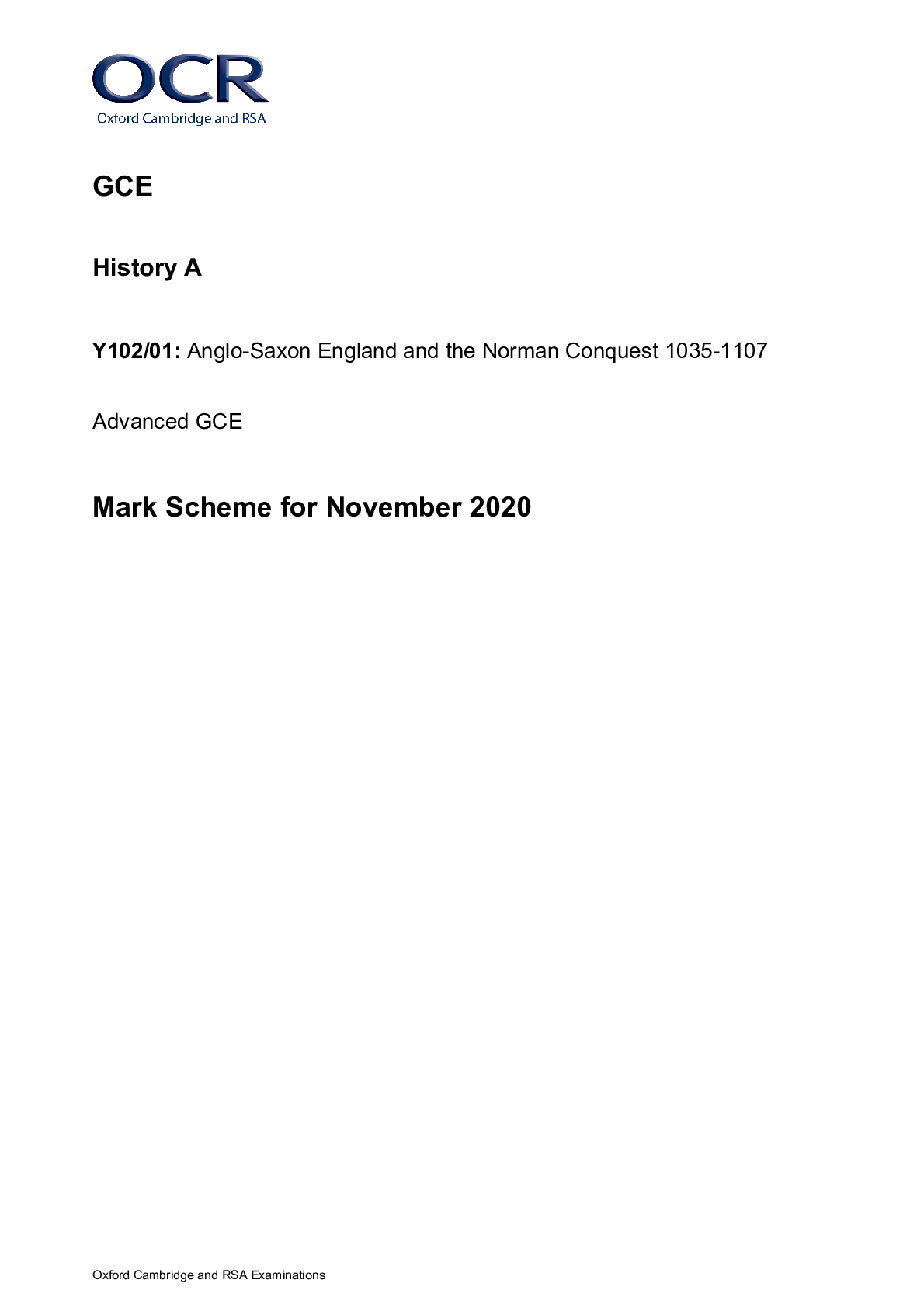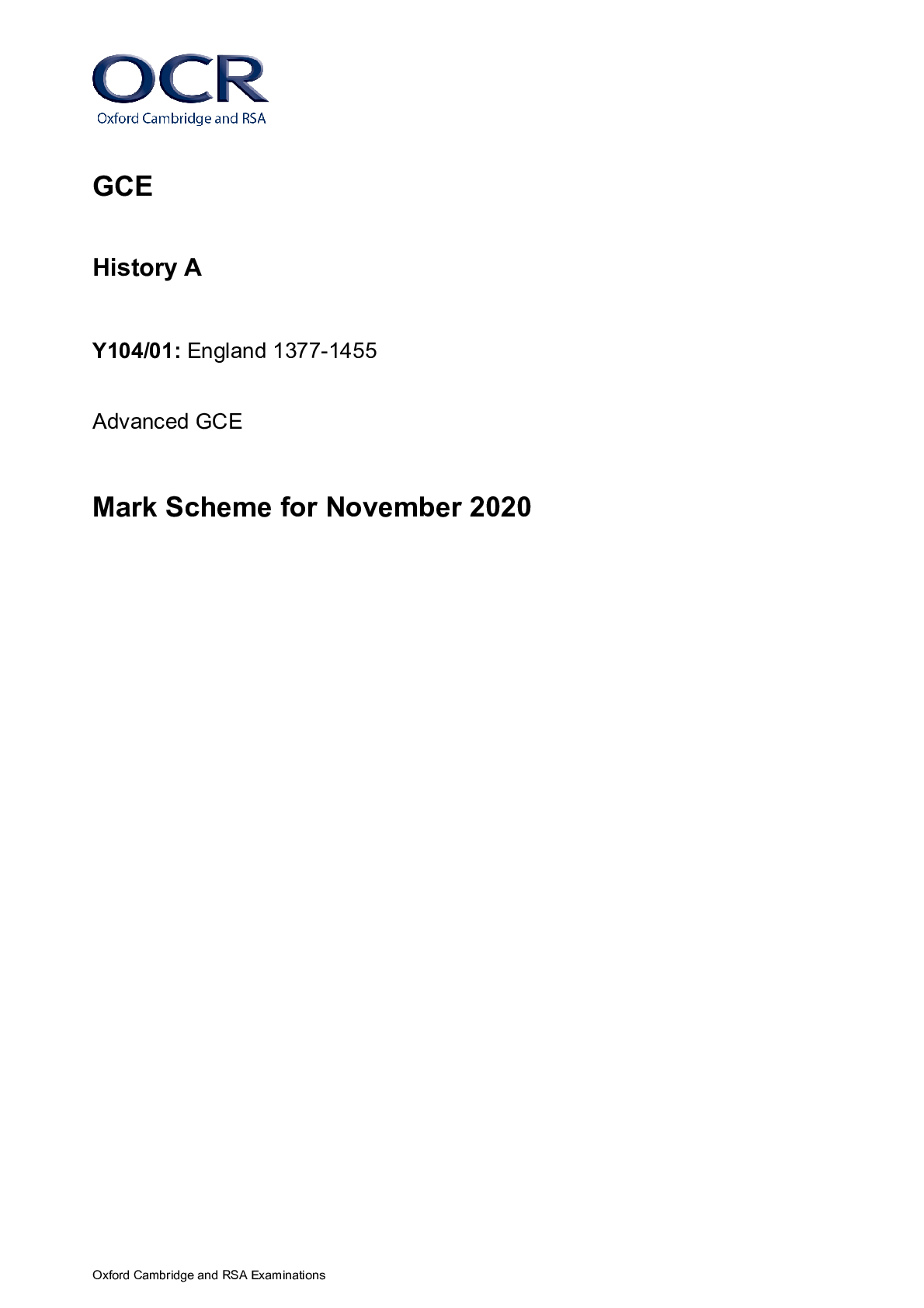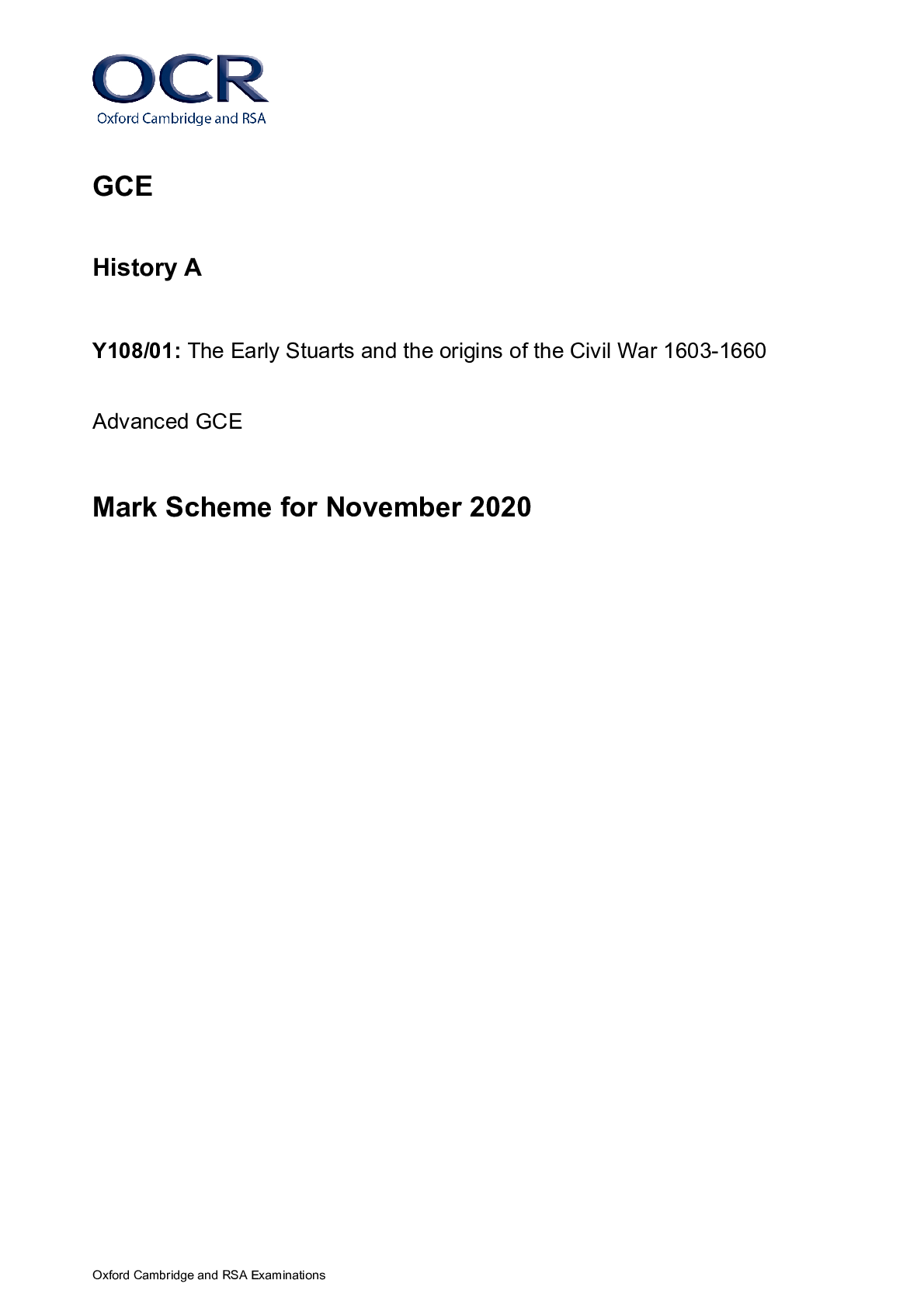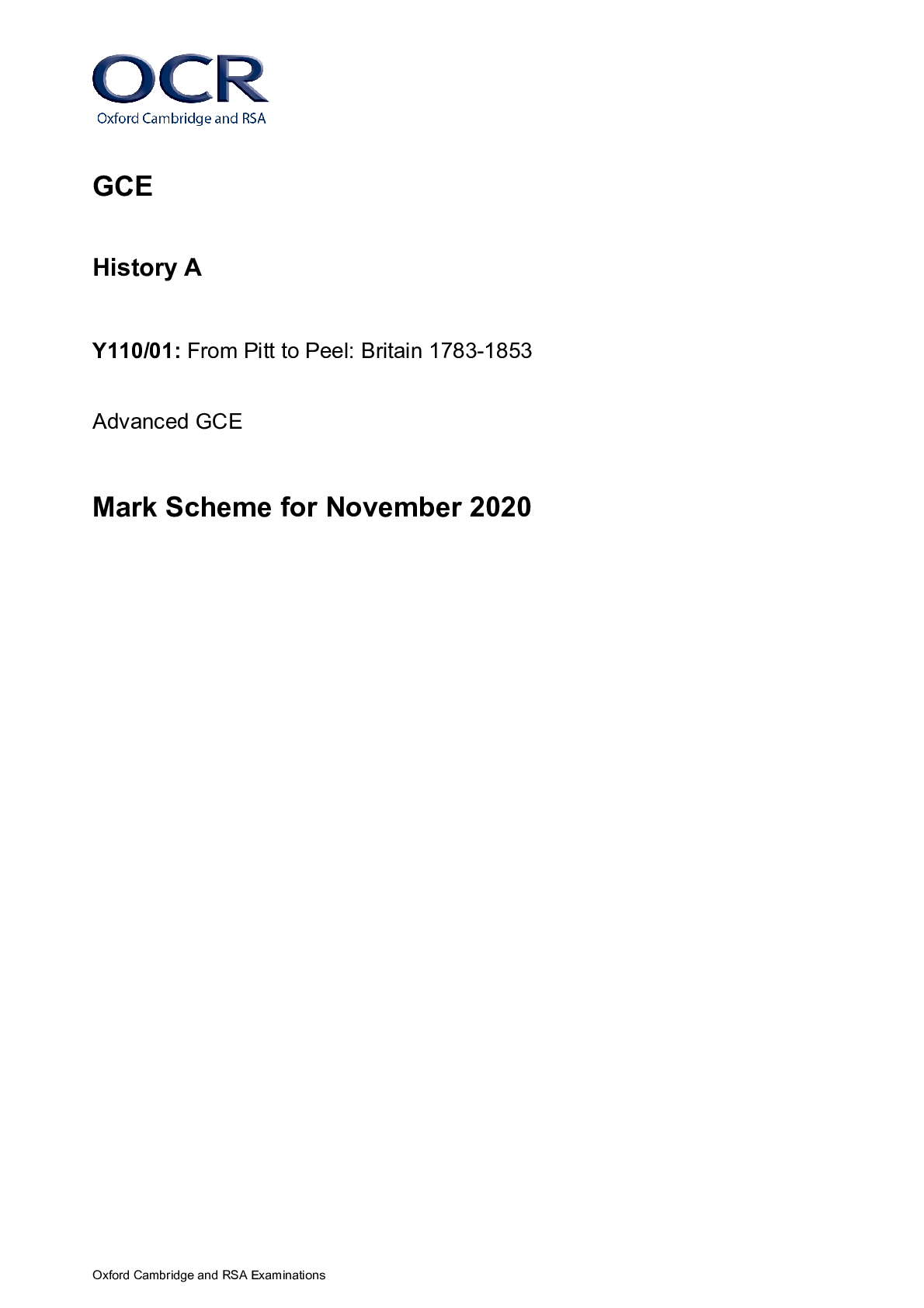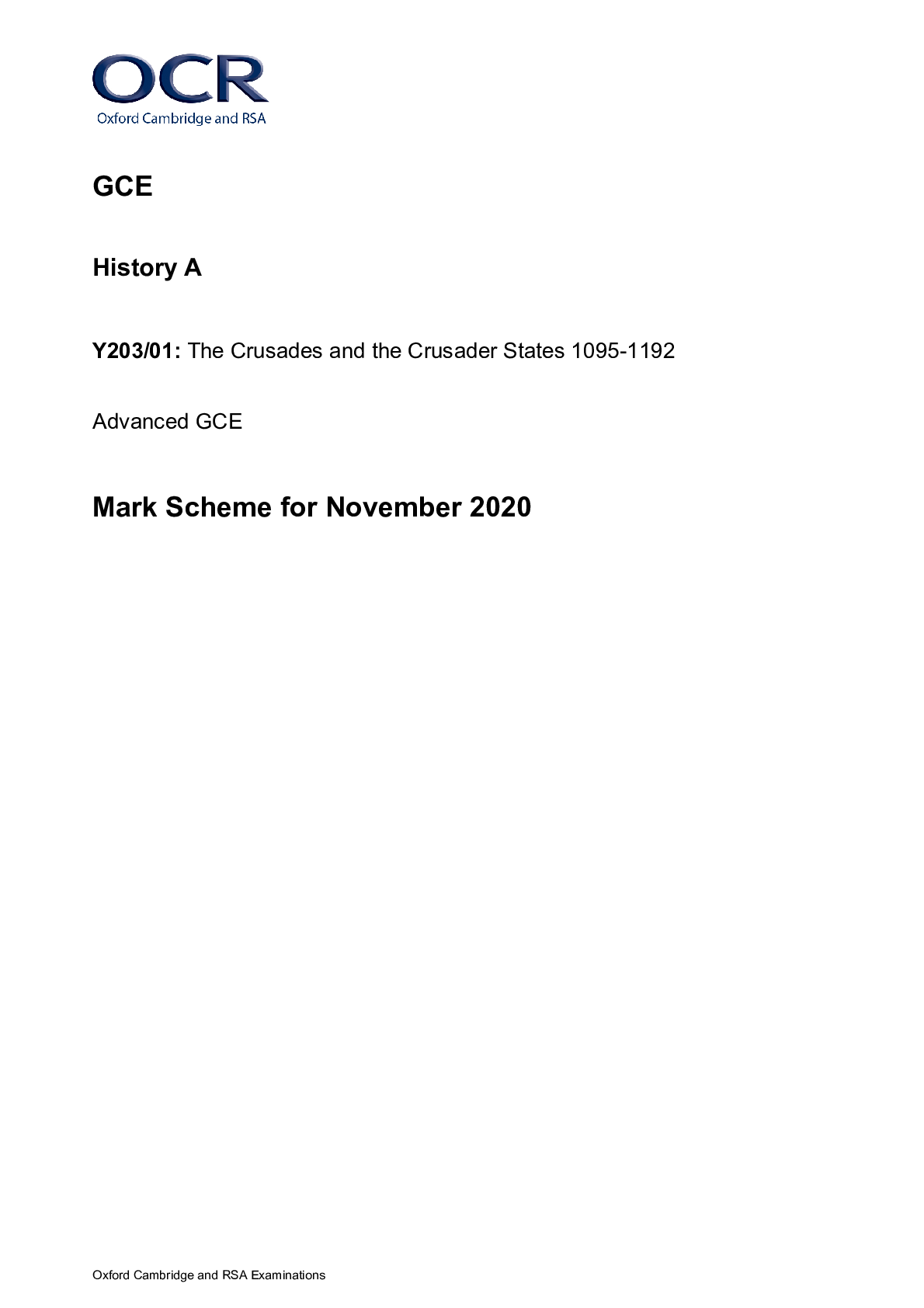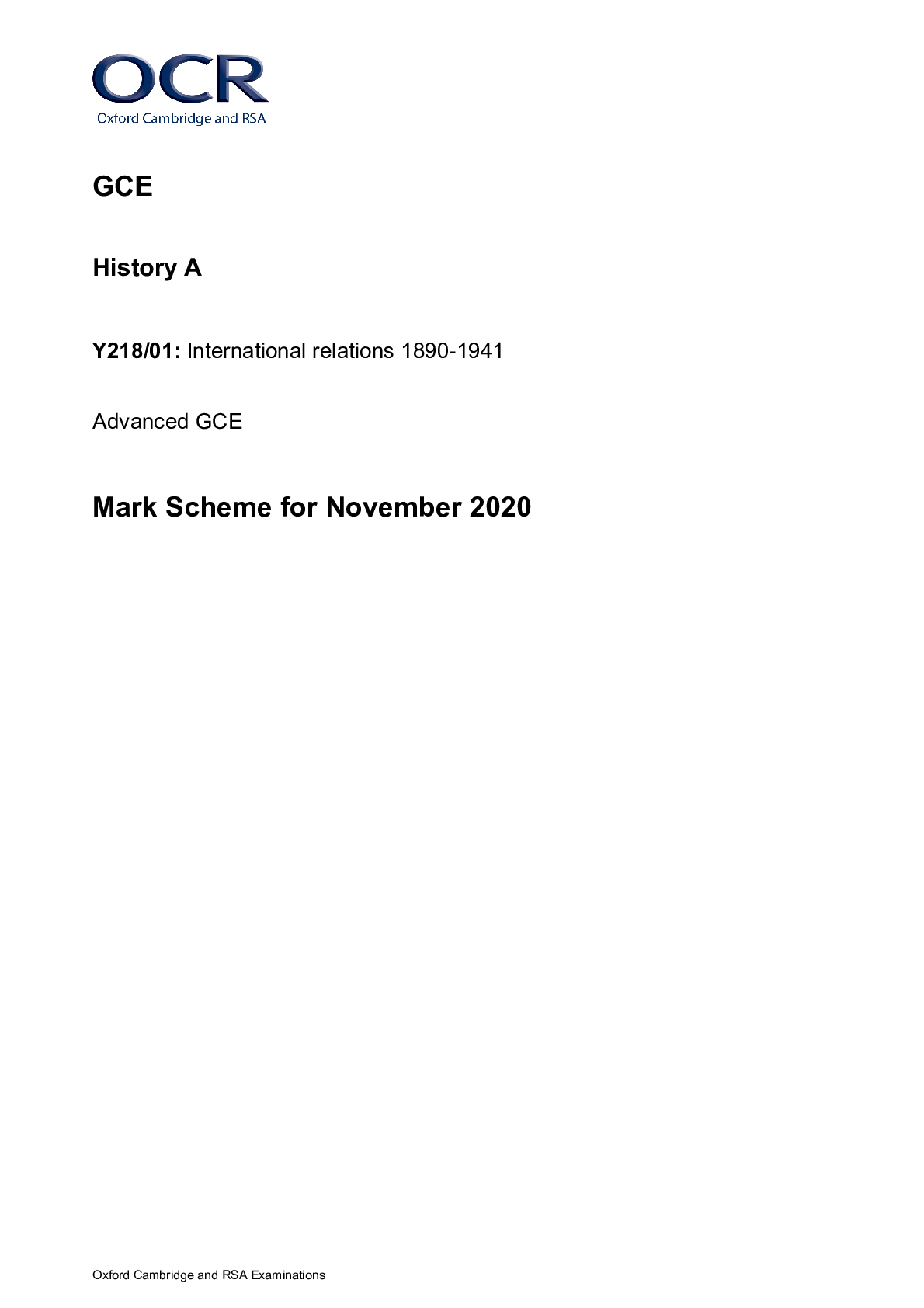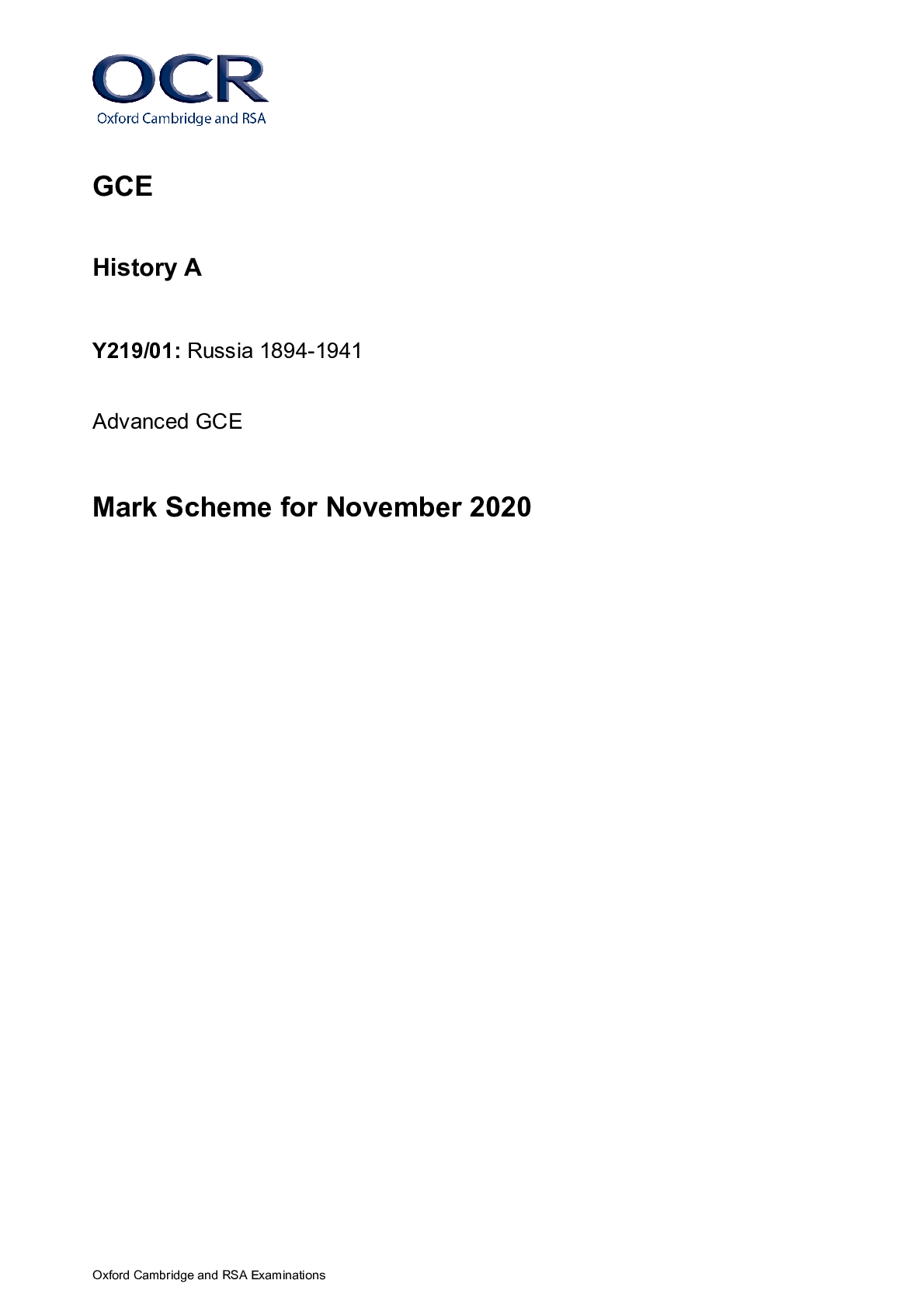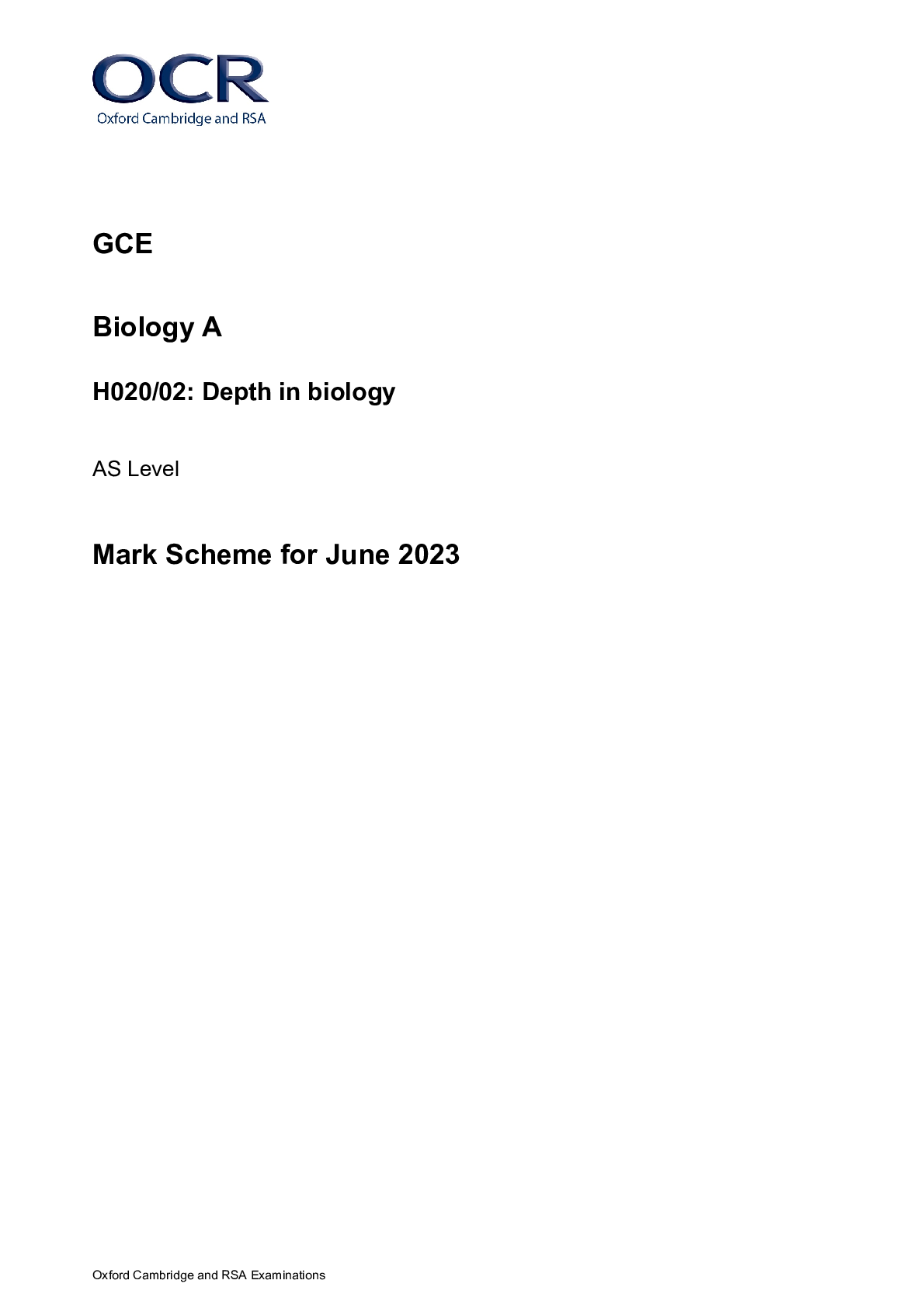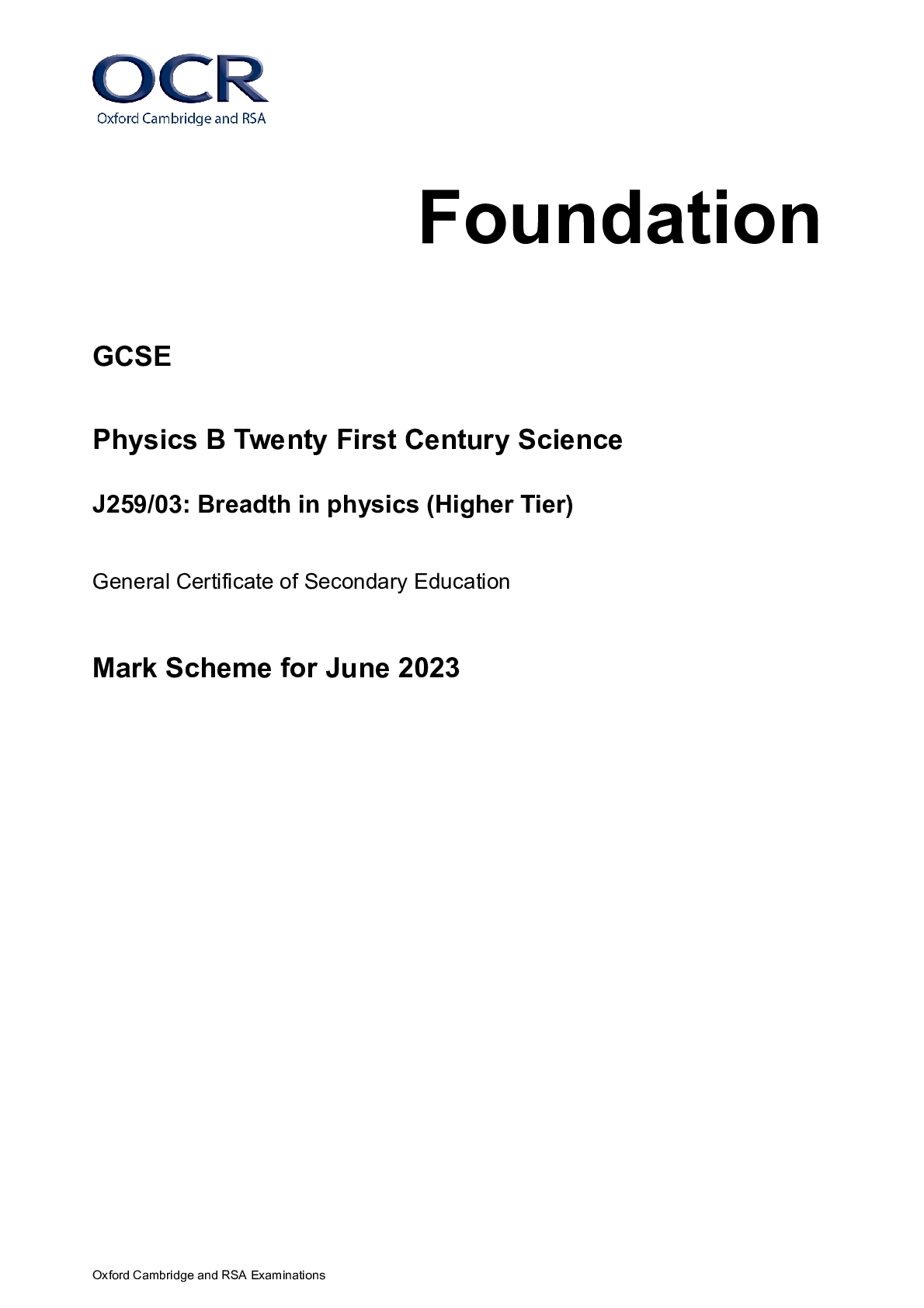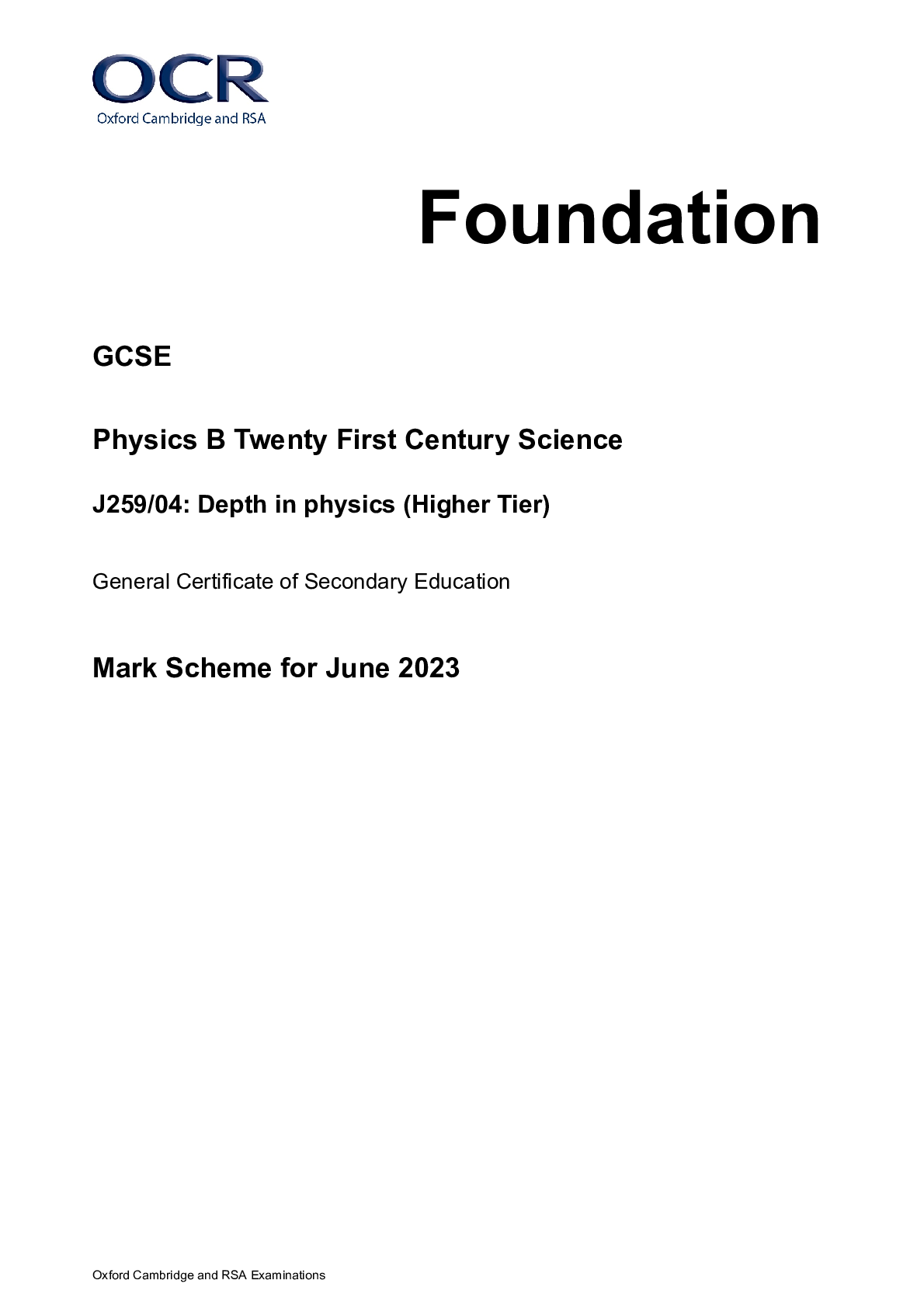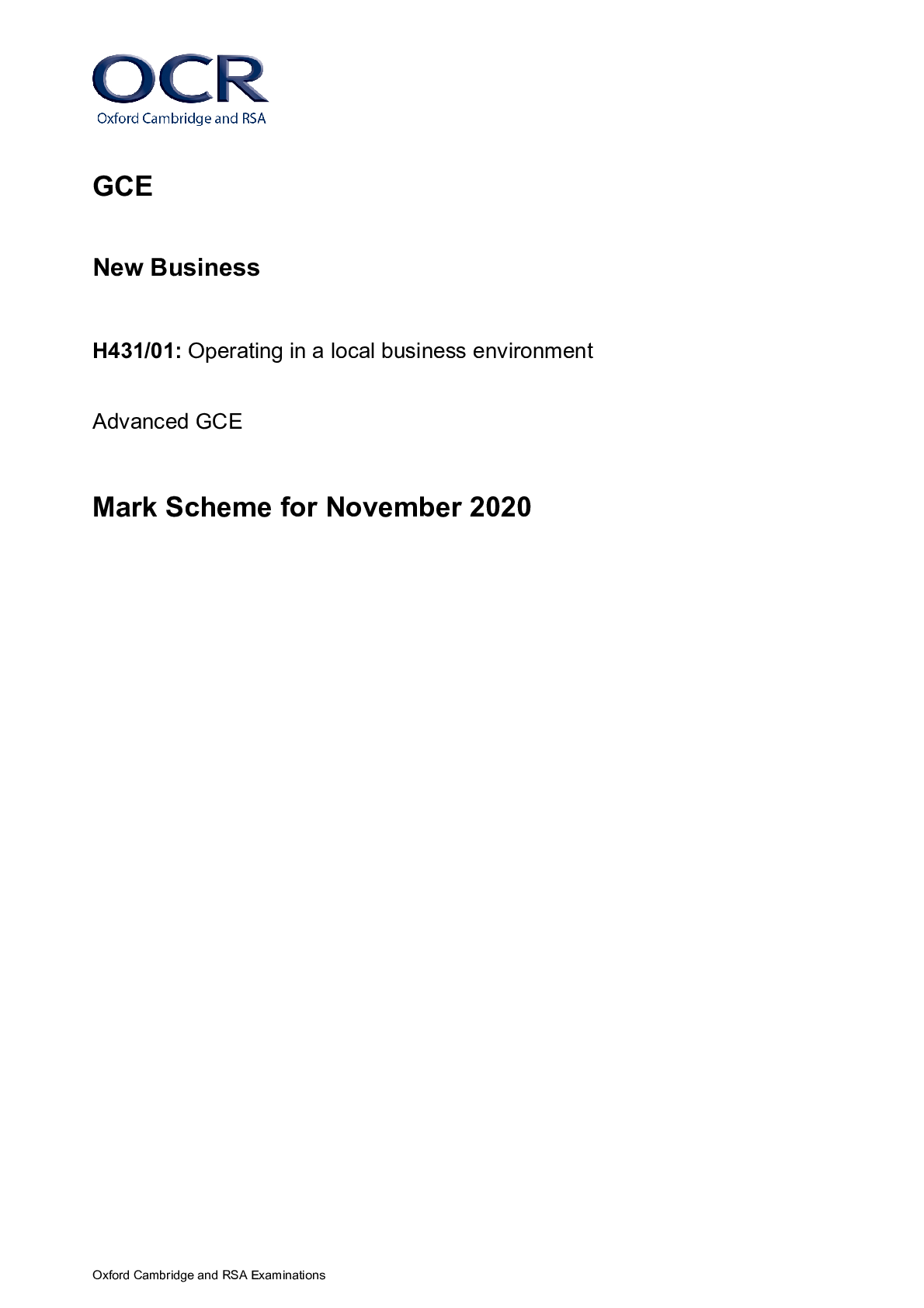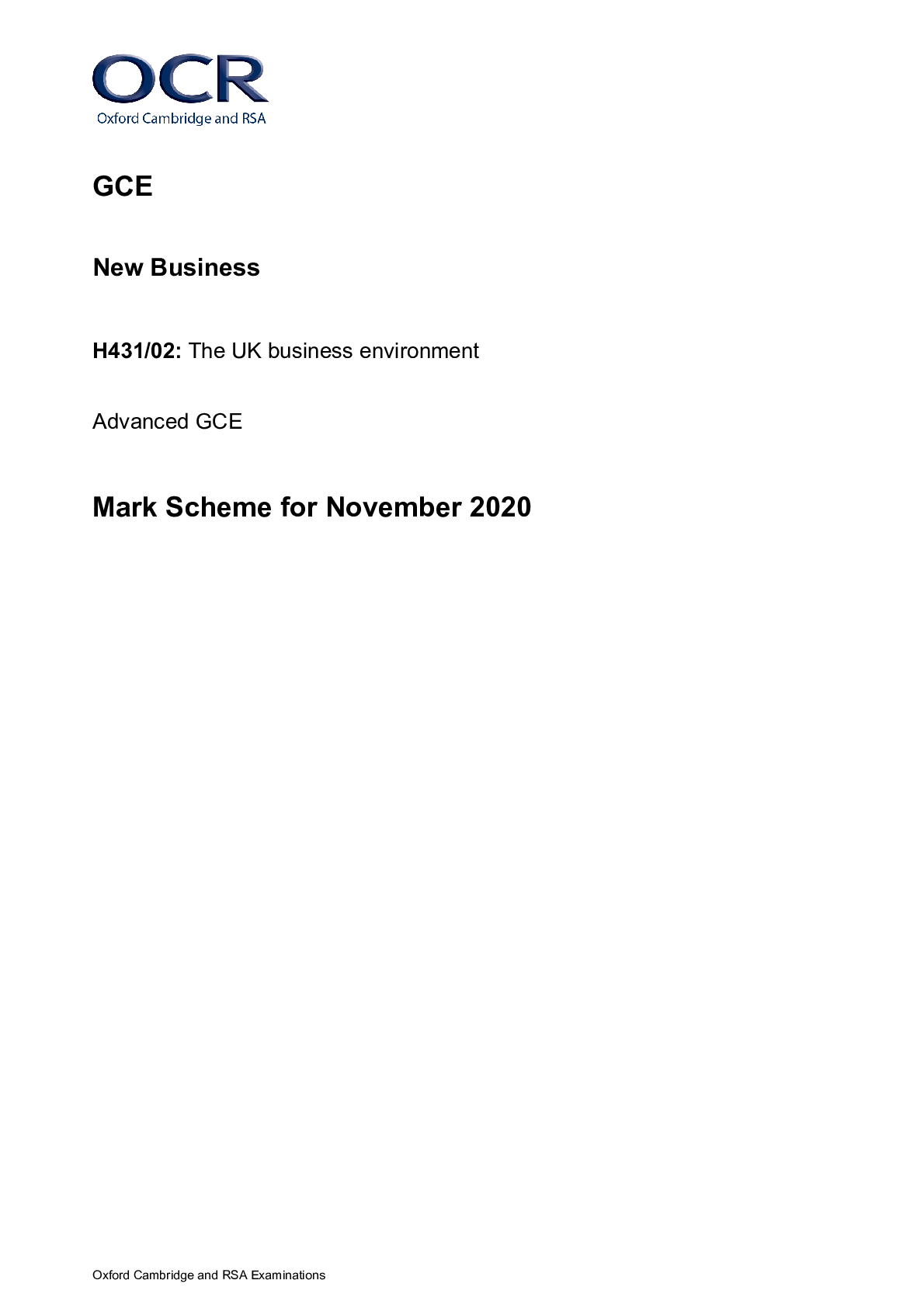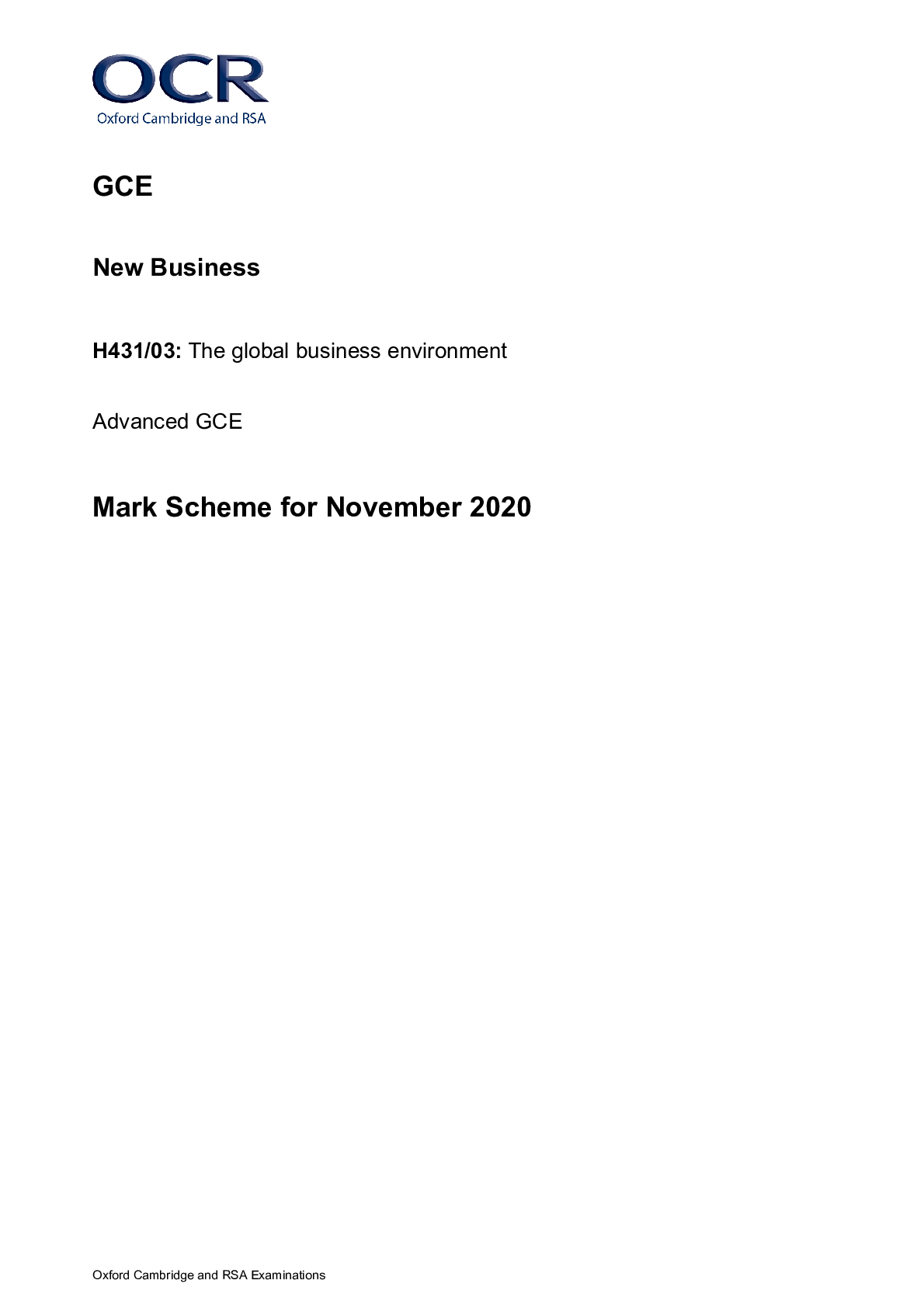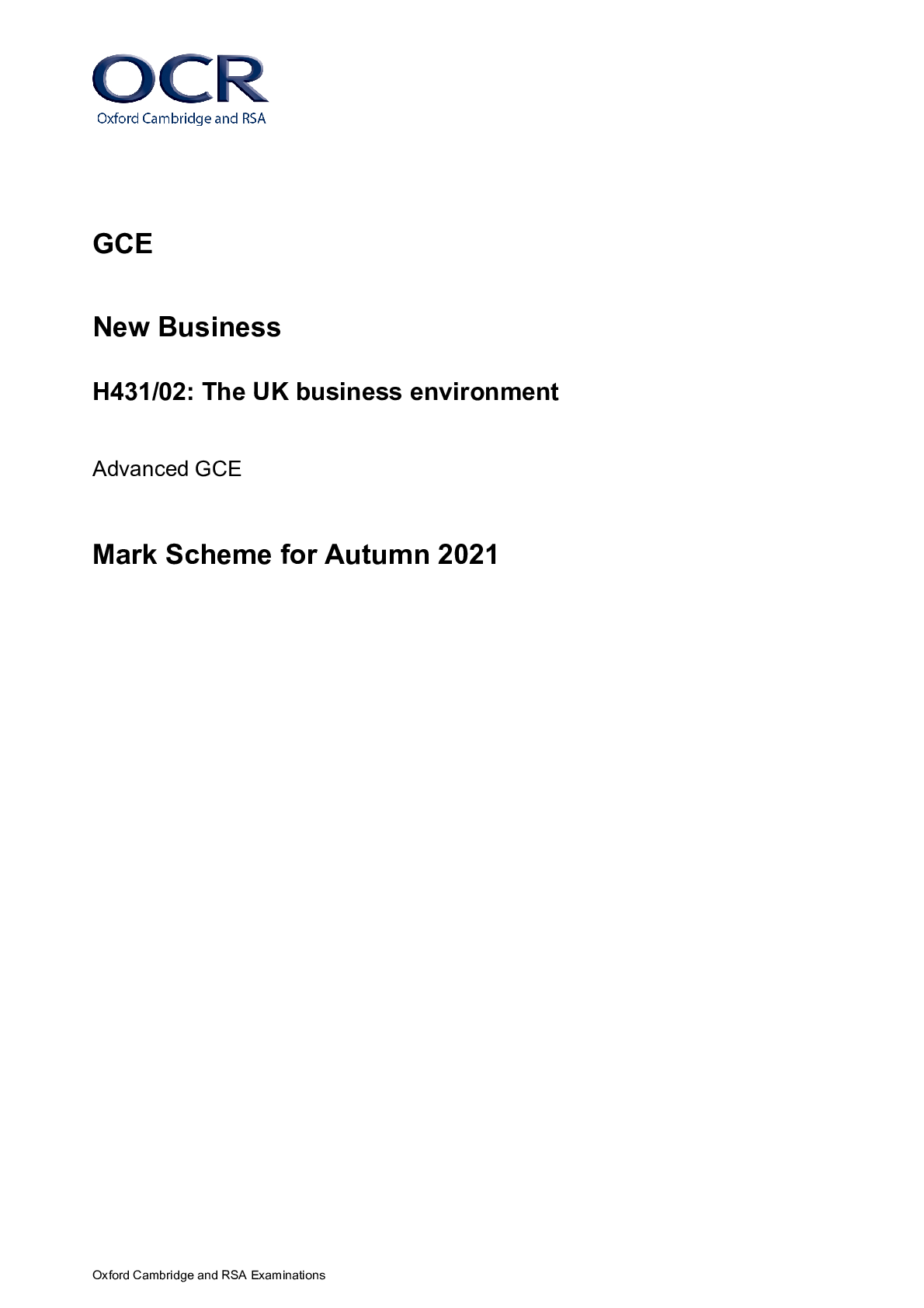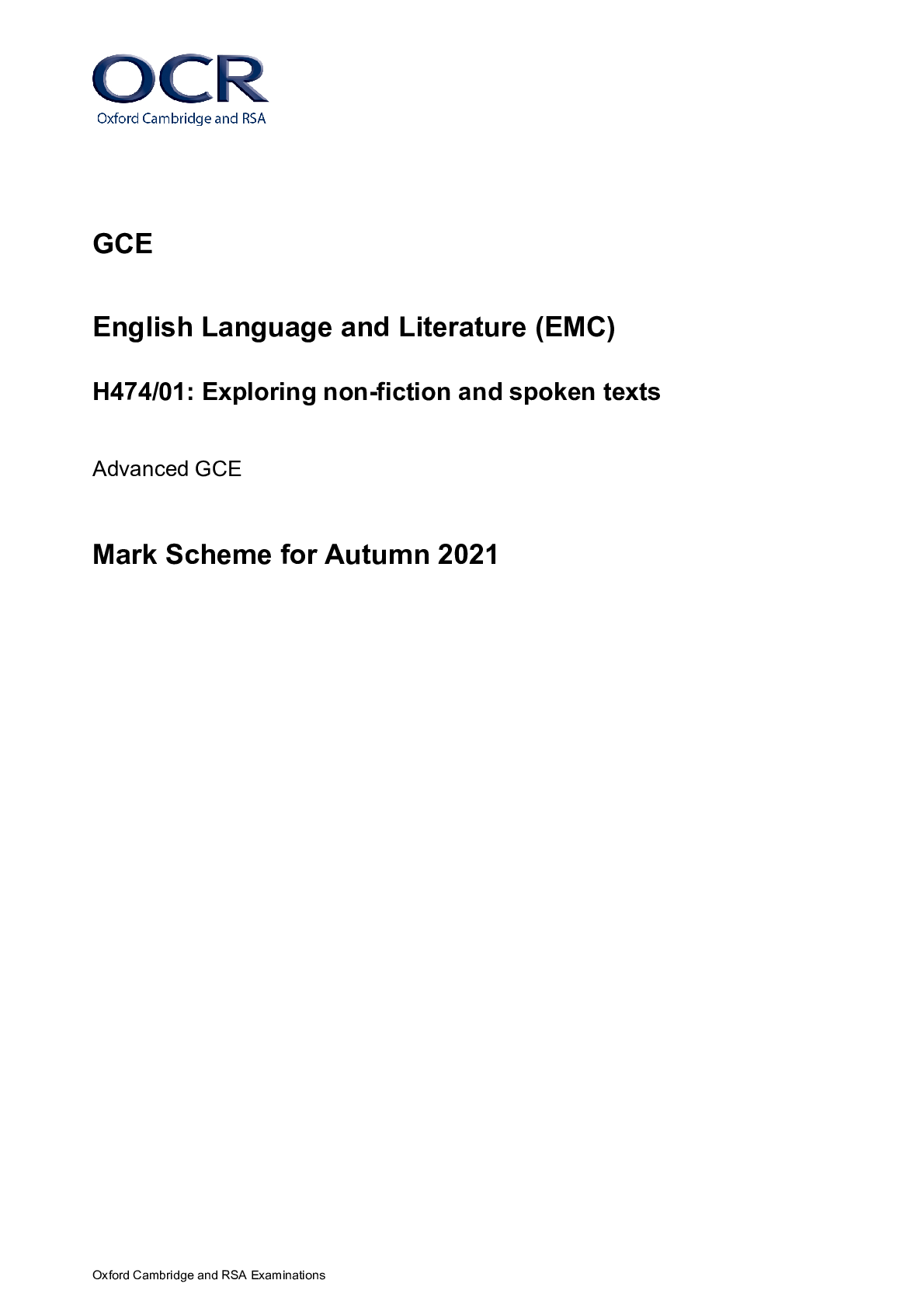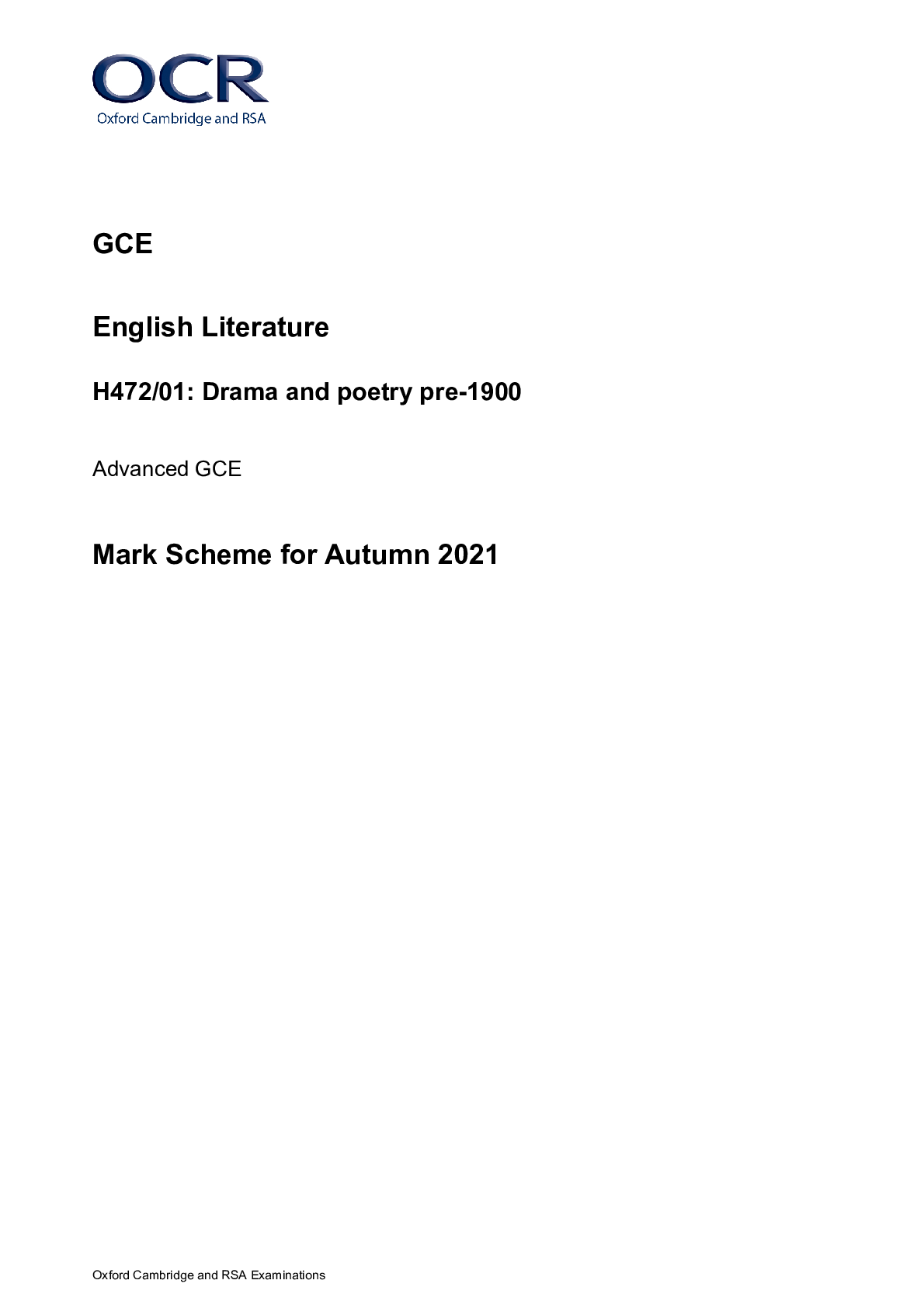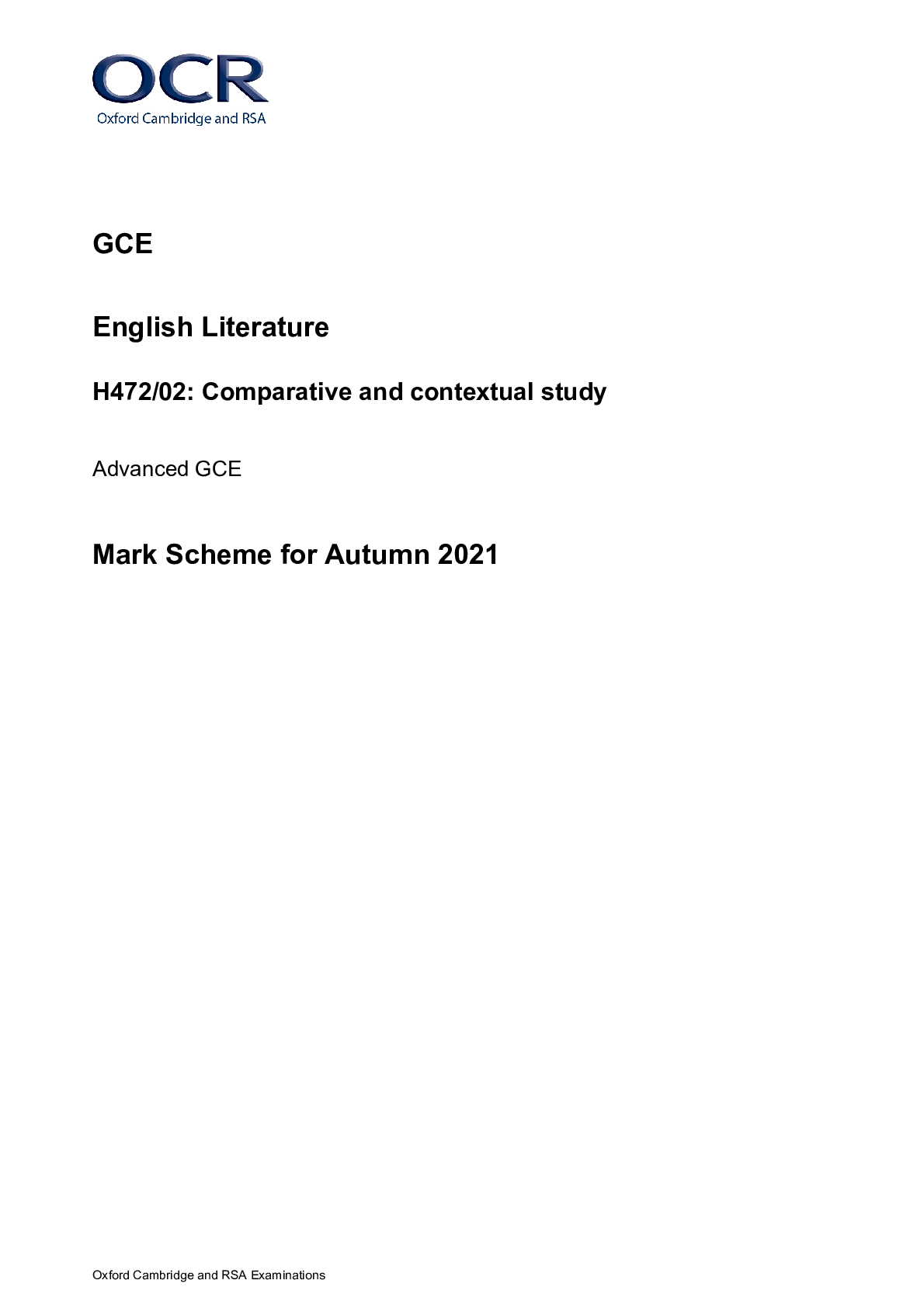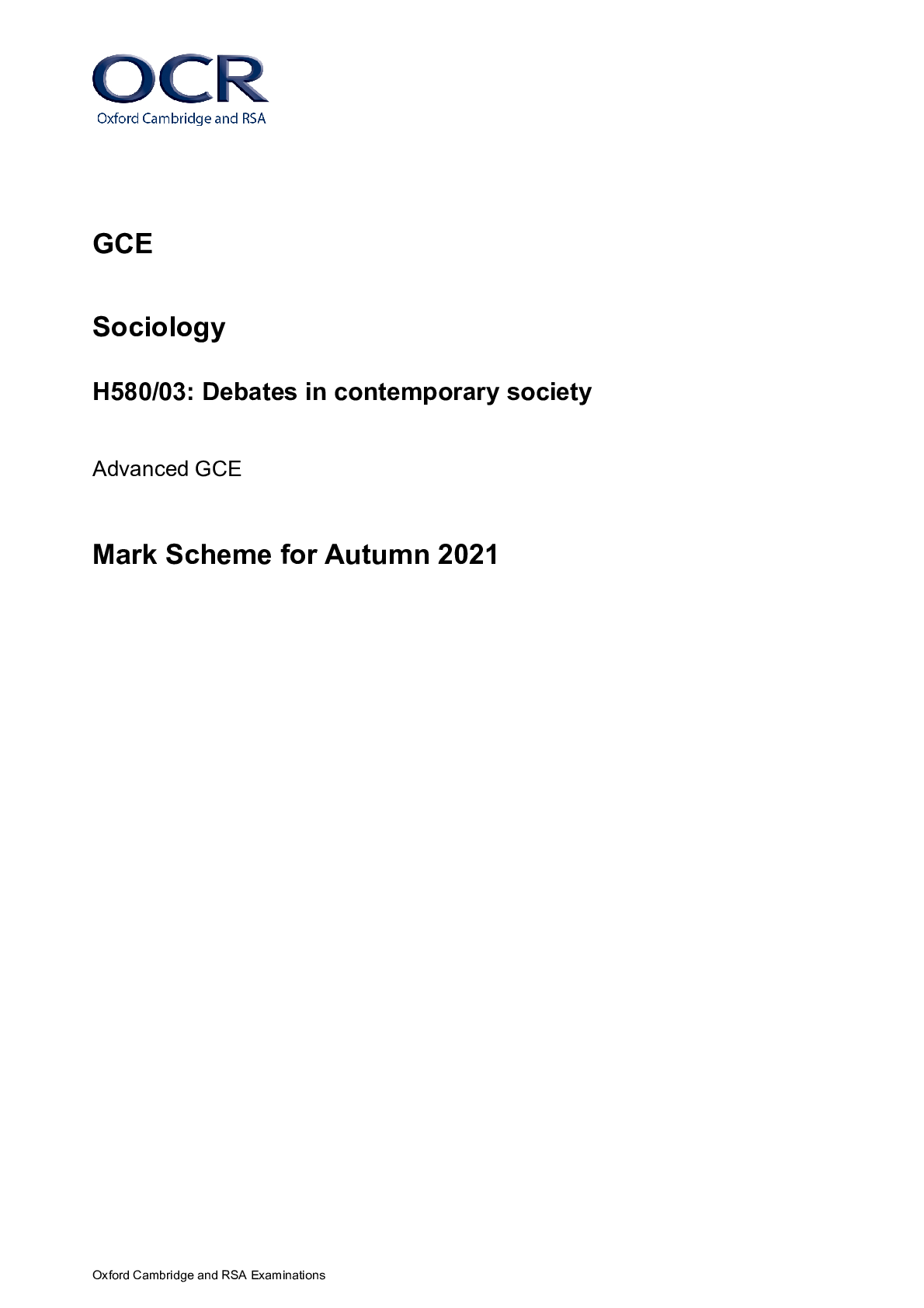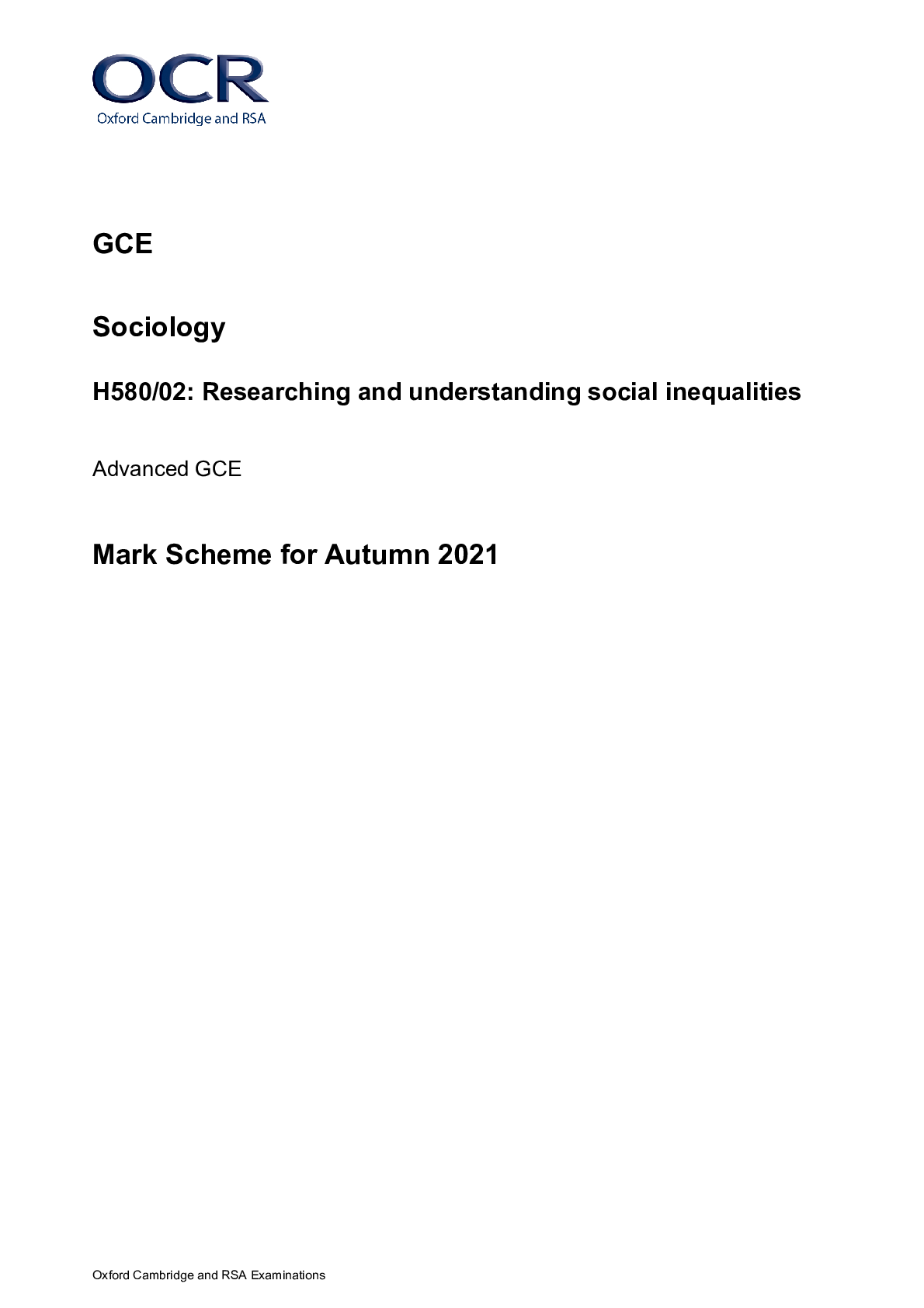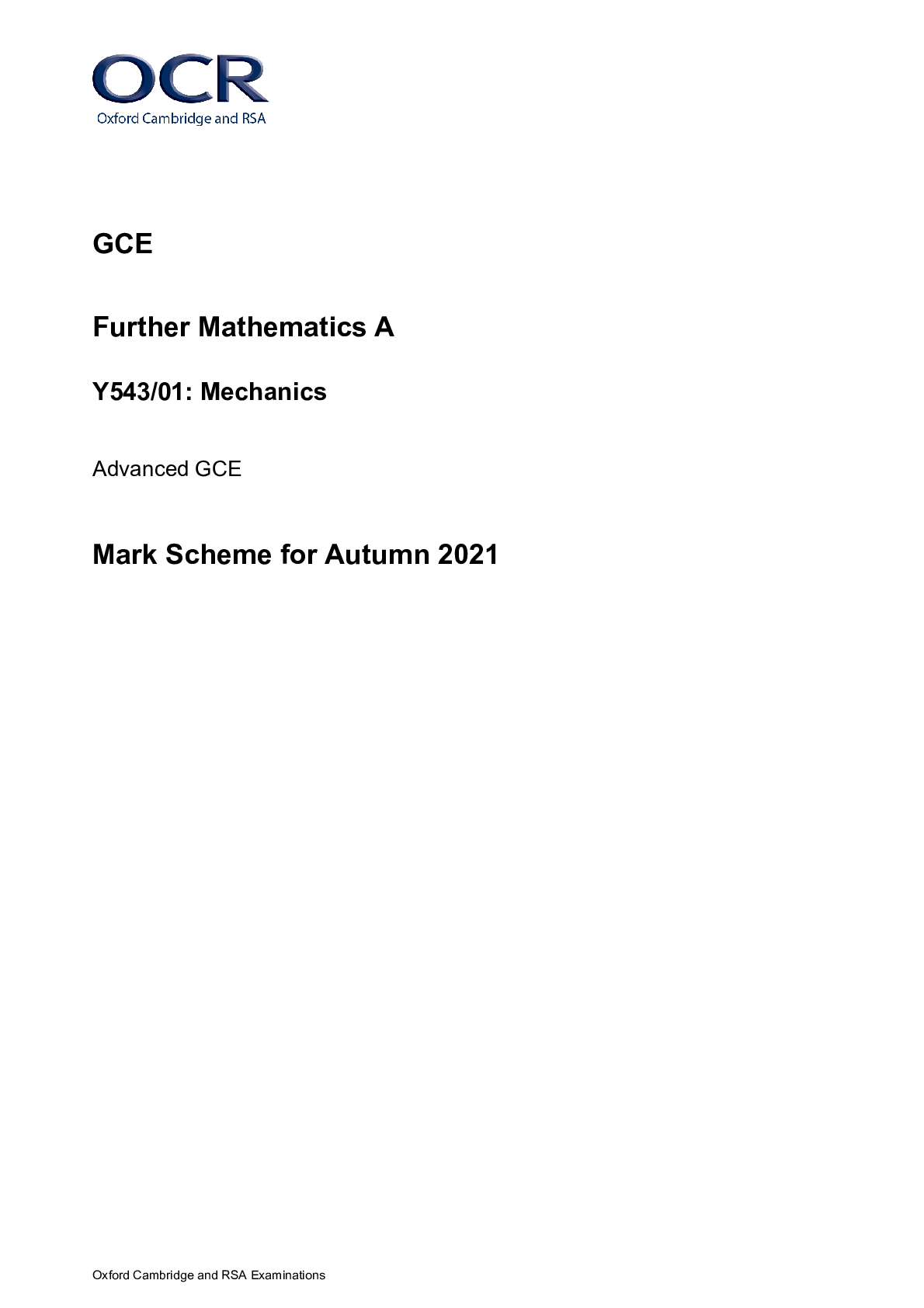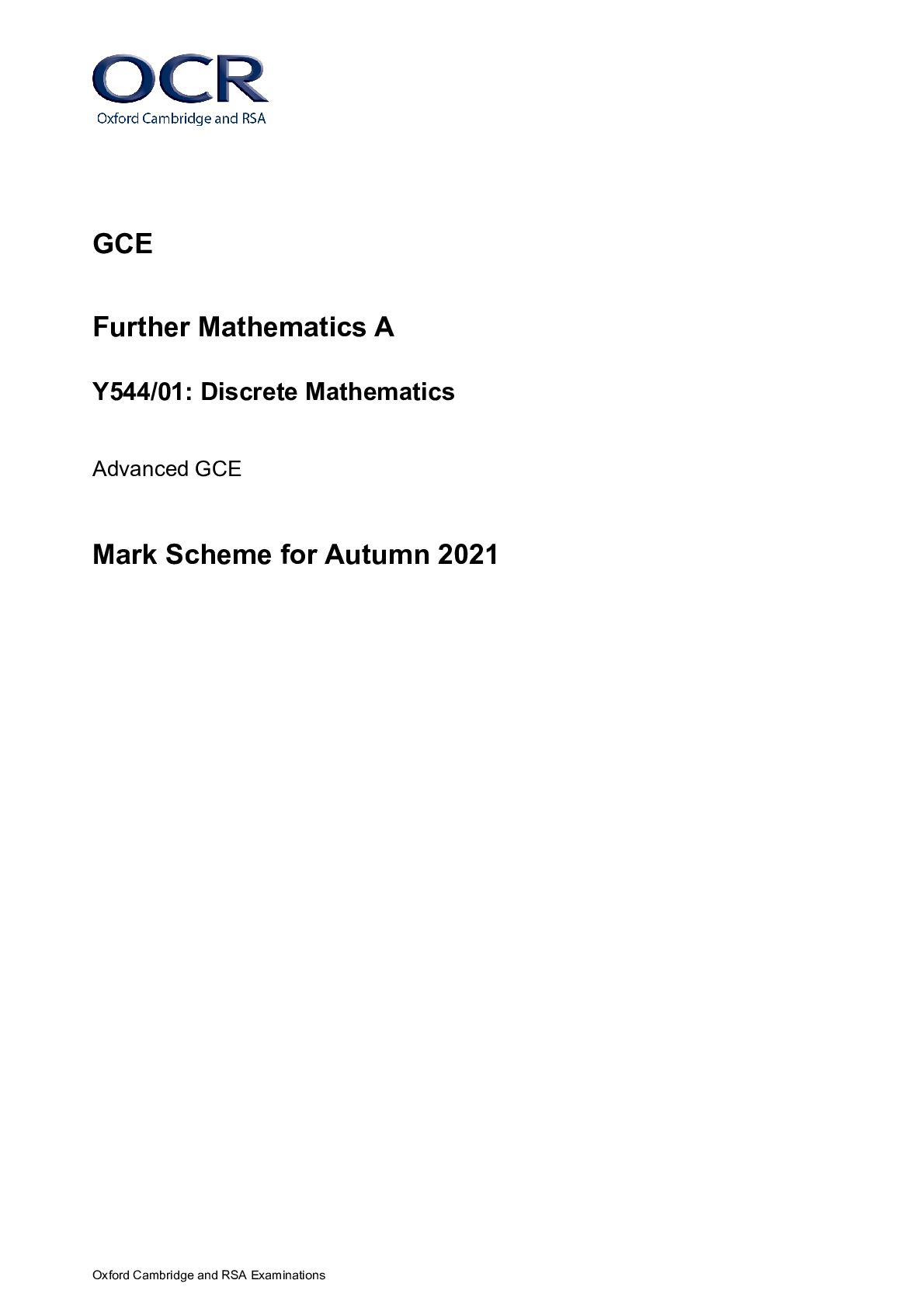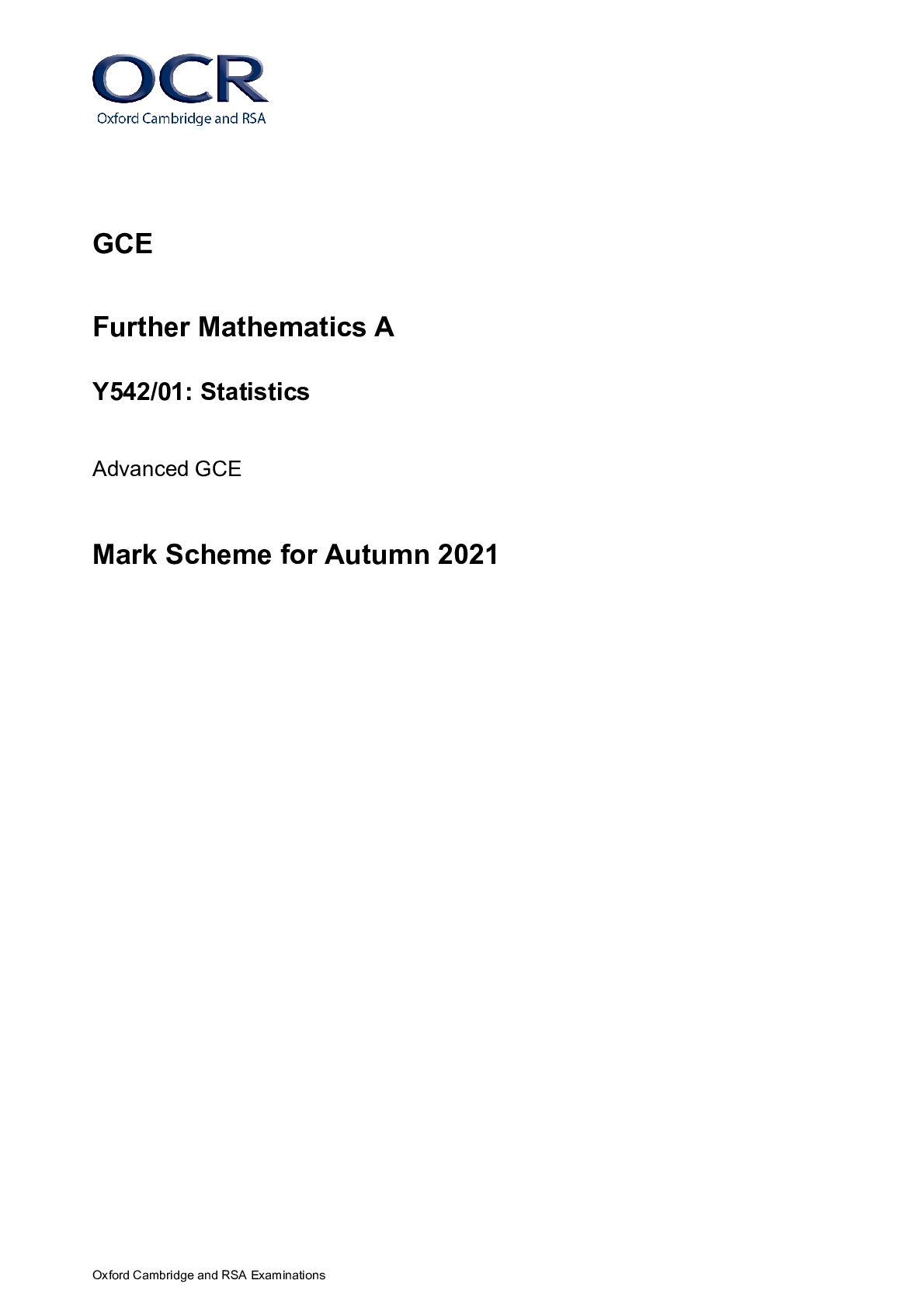History > MARK SCHEME > GCE History A Y107/01: England 1547-1603: the Later Tudors Advanced GCE Mark Scheme for November 202 (All)
GCE History A Y107/01: England 1547-1603: the Later Tudors Advanced GCE Mark Scheme for November 2020
Document Content and Description Below
GCE History A Y107/01: England 1547-1603: the Later Tudors Advanced GCE Mark Scheme for November 2020 Oxford Cambridge and RSA Examinations GCE History A Y107/01: England 1547-1603: the Later Tu... dors Advanced GCE Mark Scheme for November 2020Oxford Cambridge and RSA Examinations OCR (Oxford Cambridge and RSA) is a leading UK awarding body, providing a wide range of qualifications to meet the needs of candidates of all ages and abilities. OCR qualifications include AS/A Levels, Diplomas, GCSEs, Cambridge Nationals, Cambridge Technicals, Functional Skills, Key Skills, Entry Level qualifications, NVQs and vocational qualifications in areas such as IT, business, languages, teaching/training, administration and secretarial skills. It is also responsible for developing new specifications to meet national requirements and the needs of students and teachers. OCR is a not-for-profit organisation; any surplus made is invested back into the establishment to help towards the development of qualifications and support, which keep pace with the changing needs of today’s society. This mark scheme is published as an aid to teachers and students, to indicate the requirements of the examination. It shows the basis on which marks were awarded by examiners. It does not indicate the details of the discussions which took place at an examiners’ meeting before marking commenced. All examiners are instructed that alternative correct answers and unexpected approaches in candidates’ scripts must be given marks that fairly reflect the relevant knowledge and skills demonstrated. Mark schemes should be read in conjunction with the published question papers and the report on the examination. © OCR 20202 Annotations Annotation Meaning of annotation Blank Page Highlight Off-page comment Assertion Analysis Evaluation Explanation Factor Illustrates/Describes Irrelevant, a significant amount of material that does not answer the question Judgement Knowledge and understanding Provenance Simple comment Unclear View4 MARK SCHEME Section A Question Answer/Indicative content Mark Guidance 1 Using these four sources in their historical context, assess how far they support the view that England was a protestant country by the death of Edward VI in 1553. • In discussing how Source A does or does not support the view, answers might refer to the removal of images, whiteliming and the selling of various Catholic artefacts. • In discussing the provenance of Source A, answers might consider that it is a record from the churchwardens in a Midlands church. • In discussing the historical context of Source A, answers might consider that the record covers the whole of Edward’s reign and that some moves, such as the removal of the rood loft took place only at the end of his reign. • In discussing how Source B does not support the view, answers might refer to the lack of clergy, reading the service quickly and the lack of time available in parliament for the discussion of Church affairs. • In discussing the provenance of Source B, answers might consider that Bucer was a Protestant and might hope for faster progress; he was also writing to Calvin and might want to explain the reasons for the slow progress. • In discussing the historical context of Source B, 30 • No set answer is expected. • At Level 5 there will be judgement about the issue in the question. • To be valid judgements they must be supported by accurate and relevant material. • At Level 4 and below, answers may be simply a list of which sources support or challenge the view in the question. • Knowledge must not be credited in isolation, it should only be credited where it is used to analyse and evaluate the sources, in line with the descriptions in the levels mark scheme5 2* answers might consider that this was written near the start of Edward’s reign and that the speed of reform would increase after the fall of Somerset. • In discussing how Source C does not support the view, answers might refer to the numbers who were absent from church and had to be fined. • In discussing the provenance of Source C, answers might consider that it is from an official Act of parliament and might be designed to ‘encourage’ attendance, but it is a concern that it is passed in1552. • In discussing the historical context of Source C, answers might refer to the reaction to the First Book, which had led, at least in part to the Western Rebellion. • In discussing how Source D does support the view, answers might refer to the giving of communion in both kinds and the stress on remembrance, both of which were Protestant practices. • In discussing the provenance of Source D, answers might refer to the official nature of the source, but note that it does not mean it was used or that people accepted it. • In discussing the historical context of Source D, answers might consider that a fully Protestant service did not come in until 1552 and that it might be difficult to enforce as it was more Protestant than 1549 which had caused unrest. How far did Puritanism change during Elizabeth’s 206 reign? In arguing that Puritanism did change: • Answers might consider the growth of radicalism and separatism, such as the Brownists. • Answers might consider that at the start of the period Puritans attempted to bring about change through Parliament, using propaganda, but this was abandoned later, and separatism emerged. • Answers might consider that the term was initially used to describe more enthusiastic Protestants but by the 1570s was used to describe those who refused to use many of practices in Prayer Book. • Answers might consider that the failure of Cope’s proposals led to a change in method from Parliament, and this led to an appeal to public opinion with The Admonition to Parliament in 1572. • Answers might consider the emergence of the classis movement. In arguing that Puritanism did not change: • Answers might consider that Puritanism was always a minority movement and never attracted mass support. • Answers might consider that Puritans continued to object to wearing surplices and continued to raise objections to vestments. • Answers might consider that Puritans continued to oppose elements of the Thirty-Nine Articles. • No set answer is expected. • At higher levels, candidates will focus on weighing up the extent of change; but at Level 4, may simply list changes). • At Level 5 there will be judgement as to whether ‘Puritanism did change’ or not. • At higher Levels candidates might establish criteria against which to judge ‘change’. • To be valid judgements, claims must be supported by relevant and accurate material. If not, they are assertions. • Knowledge must not be credited in isolation, it should only be credited where it is used as the basis for analysis and evaluation, in line with descriptions in the levels mark scheme.7 3* • Answers might consider that Puritans continued to attempt to change the Prayer Book. • Answers might consider that throughout Puritans continued to try and raise clerical standards and supported efforts through prophesyings. How serious were the problems Elizabeth faced in the period after 1588? In arguing that the problems were serious: • Answers might consider that the social and economic problems of inflation and bad harvests were serious. • Answers might consider that unrest in Ireland, with Tyrone, was serious as it cost a lot and took until her death to suppress it. • Answers might consider that the threat from Spain remained, with two further Armadas and support for Tyrone. • Answers might consider the problem of finance, which was made worse by the cost of war. • Answers might consider the problem of her relations with Parliament over issues such as Monopolies. • Answers might consider the factional unrest between Cecil and Essex. 20 • No set answer is expected. • At higher levels, candidates will focus on weighing up the seriousness of problems; but at Level 4, may simply list problems. • At Level 5 there will be judgement as to whether the problems Elizabeth faced at that time were serious. • At higher Levels candidates might establish criteria against which to evaluate ‘how serious’ different problems were. • To be valid judgements, claims must be supported by relevant and accurate material. If not, they are assertions. • Knowledge must not be credited in isolation, it should only be credited where it is used as the basis for analysis and evaluation, in line with descriptions in the levels mark scheme.8 In arguing that the problems were not serious: • Answers might consider the lack of support for the Oxfordshire Rising of 1596. • Answers might consider the limited unrest caused by the social and economic problems. • Answers might consider that Spain was no longer such a threat after 1588. • Answers might consider that her Golden Speech and reforms to monopolies won her parliamentary support. • Answers might consider that the Essex rebellion was crushed easily. • Answers might consider that factional unrest did not disrupt the running of government. • Answers might consider that there was little loss of popular support. • Answers might consider that the religious problems with the Catholics and Puritans were largely defeated.9 APPENDIX 1 – this contains a generic mark scheme grid AO2: Analyse and evaluate appropriate source materials, primary and/or contemporary to the period, within its historical context. Generic mark scheme for Section A, Question 1: How far do the four sources support the view? [30] Level 6 26–30 marks The answer has a very good focus on the question throughout. The sources are fully evaluated, using both provenance and detailed and accurate knowledge of their historical context in a balanced way, in order to engage with the sources and reach a convincing, fully supported analysis of them in relation to the issue in the question. Level 5 21–25 marks The answer has a good focus on the question. The sources are evaluated, using both provenance and relevant knowledge of their historical context, in order to engage with the sources and reach a supported analysis of them in relation to the issue in the question. There may be some imbalance in the analysis between use of provenance and use of knowledge. Level 4 16–20 marks The answer is mostly focused on the question. The sources are evaluated, using both provenance and generally relevant knowledge of their historical context, in order to engage with the sources and produce an analysis of them in relation to the question. The use of provenance may not be developed. Level 3 11–15 marks The answer is partially focused on the question. There is partial evaluation of the sources, with use of some knowledge of their historical context, in order to engage with the sources and produce a partial analysis of them in relation to the question. Level 2 6–10 marks The answer has only limited focus on the question. Evaluation of the sources is very general. There is limited use of generalized knowledge of historical context to engage with the sources and produce a basic analysis of them in relation to the question. Level 1 1–5 marks This answer is on the wider topic area, but not on the detail of the question. The sources are evaluated in a very basic way, primarily being used as a source of information with understanding of them being only partial. A very generalised knowledge of historical context is used in a very limited way to engage with the sources and to attempt a very simple analysis of them in relation to the question. 0 marks No evidence of understanding or reference to the sources.10 AO1: Demonstrate, organise and communicate knowledge and understanding to analyse and evaluate the key features related to the periods studied, making substantiated judgements and exploring concepts, as relevant, of cause, consequence, change, continuity, similarity, difference and significance. Generic mark scheme for Section B, Questions 2 and 3: Essay[20] Level 6 17–20 marks There is a consistent focus on the question throughout the answer. Accurate and detailed knowledge and understanding is demonstrated throughout the answer and is consistently evaluated and analysed in order to reach substantiated, developed and sustained judgements. There is a well-developed and sustained line of reasoning which is coherent and logically structured. The information presented is entirely relevant and substantiated. Level 5 13–16 marks There is a mostly consistent focus on the question. Generally accurate and detailed knowledge and understanding is demonstrated through most of the answer and is evaluated and analysed in order to reach substantiated judgements, but these are not consistently well-developed. There is a well-developed line of reasoning which is clear and logically structured. The information presented is relevant and in the most part substantiated. Level 4 10–12 marks The question is generally addressed. Generally accurate and sometimes detailed knowledge and understanding is demonstrated through most of the answer with evaluation and some analysis, and this is used appropriately to support the judgements that are made. There is a line of reasoning presented with some structure. The information presented is in the most-part relevant and supported by some evidence. Level 3 7–9 marks The question is partially addressed. There is demonstration of some relevant knowledge and understanding, which is evaluated and analysed in parts of the answer, but in places knowledge is imparted rather than being used. The analysis is appropriately linked to the judgements made, though the way in which it supports the judgements may not always be made explicit. The information has some relevance and is presented with limited structure. The information is supported by limited evidence. Level 2 4–6 marks The focus is more on the topic than the specific demands of the question. Knowledge and understanding is limited and not well used, with only limited evaluation and analysis, which is only sometimes linked appropriately to the judgements made. The information has some relevance, but is communicated in an unstructured way. The information is supported by limited evidence and the relationship to the evidence may not be clear. Level 1 1–3 marks The answer relates to the topic but not the specific question. The answer contains only very limited relevant knowledge which is evaluated and analysed in a very limited way. Judgements are unsupported and are not linked to analysis. Relevant knowledge is limited, generalised and poorly used; attempts at argument are no more than assertion. Information presented is basic and may be ambiguous or unstructured. The information is supported by limited evidence. 0 marks No evidence of understanding and no demonstration of any relevant knowledge.11 APPENDIX 2 – this section contains additional subject specific information Use this space if you have extensive subject specific information that is inappropriate to include elsewhere.OCR (Oxford Cambridge and RSA Examinations) The Triangle Building Shaftesbury Road Cambridge CB2 8EA [Show More]
Last updated: 1 year ago
Preview 1 out of 12 pages

Reviews( 0 )
Document information
Connected school, study & course
About the document
Uploaded On
Jul 17, 2022
Number of pages
12
Written in
Additional information
This document has been written for:
Uploaded
Jul 17, 2022
Downloads
0
Views
33

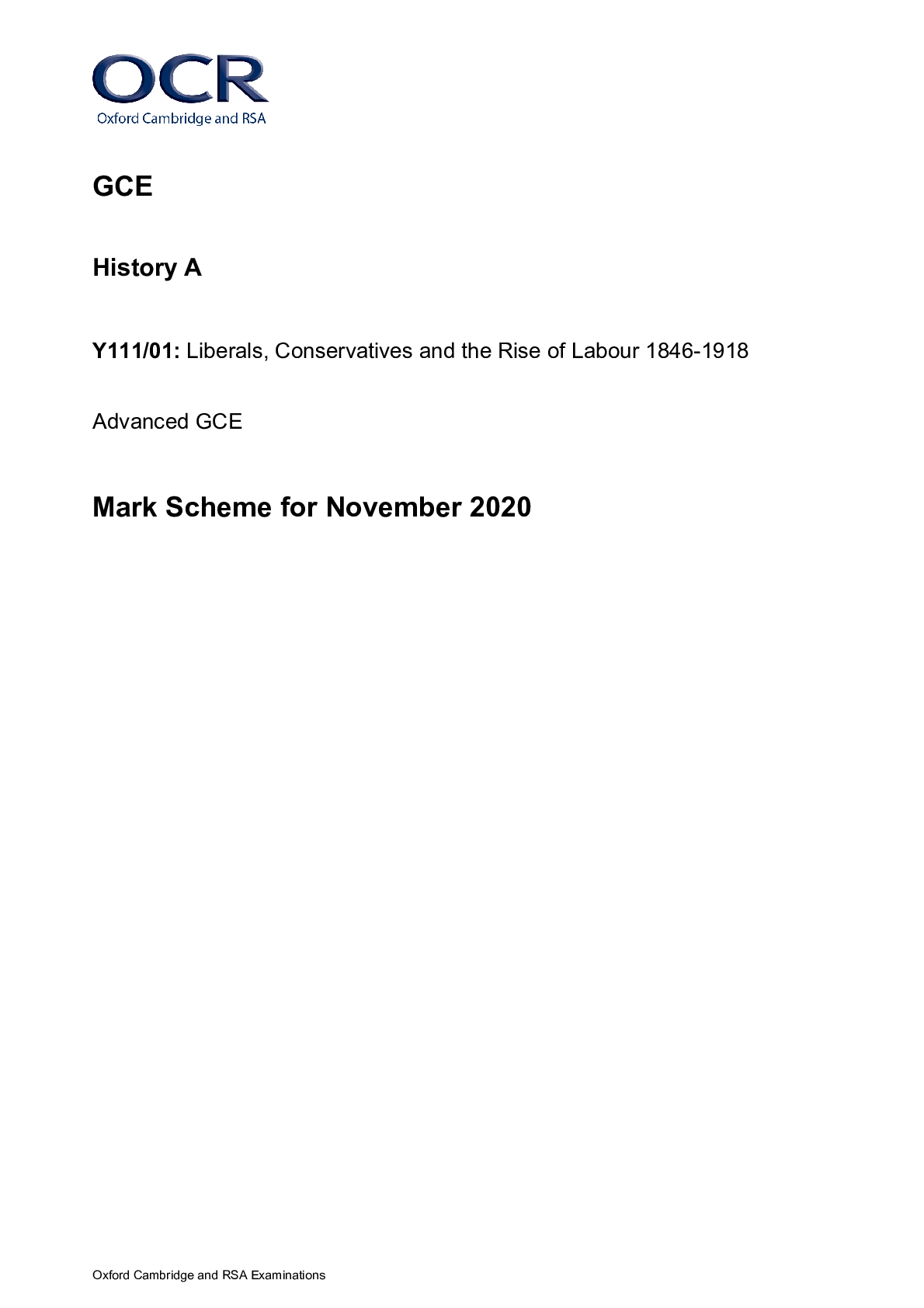
.png)
